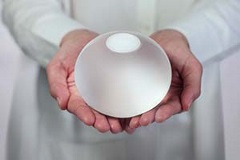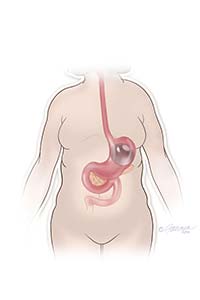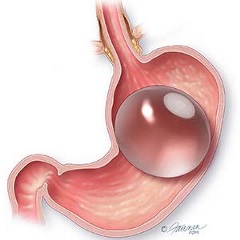Intragastric Balloon System
Call (888) DMC-2500 for a Physician Referral
Safe, Nonsurgical and Noninvasive Device to Help You Lose Weight
 Made of soft silicone, the durable intragastric balloon is a safe, nonsurgical and noninvasive device to help you lose weight. There are no incisions, stitches or scars. The balloon is inserted orally through your esophagus and placed directly into
your stomach during an outpatient procedure. The balloon reduces the amount you can eat and your body can better anticipate when your stomach is getting full.1 After six months, the balloon is removed.
Made of soft silicone, the durable intragastric balloon is a safe, nonsurgical and noninvasive device to help you lose weight. There are no incisions, stitches or scars. The balloon is inserted orally through your esophagus and placed directly into
your stomach during an outpatient procedure. The balloon reduces the amount you can eat and your body can better anticipate when your stomach is getting full.1 After six months, the balloon is removed.
How to Know if the Balloon is Right for You
The first step is a consultation with a DMC physician. You will review your medical history, current health, body mass index (BMI), how it works, benefits and risks.
The intragastric balloon is a weight loss aid for adults suffering from obesity with a BMI between 30 and 40 who have not been able to lose weight and keep it off.2 You must be willing to follow a 12-month program, beginning with the placement of the balloon and continuing for six months after it’s removed, which includes a healthy diet and exercise plan.
How it Works
 The balloon helps you eat less to lose weight without invasive surgery. It’s FDA approved and has been proven to be safe and effective.
The balloon helps you eat less to lose weight without invasive surgery. It’s FDA approved and has been proven to be safe and effective.
Your DMC gastroenterologist will insert the balloon in a quick, nonsurgical outpatient procedure. The balloon is not permanent and it will be removed after six months.
Patients can experience up to 3.1x more weight loss than diet and exercise alone3 within six months after the balloon is placed. For the remaining six months of the program, you’ll continue working closely with your doctor to follow a personalized diet and exercise program.
What to Expect with an Intragastric Balloon
You are sedated and the balloon is inserted orally through your esophagus and placed directly into your stomach during a quick, nonsurgical procedure. No incisions, stitches or scars.
The balloon reduces the volume of your stomach, allowing you to get fuller with smaller meals, which supports weight loss.1 Your physician will help you make and maintain major changes in your eating and exercise habits. After six months, your physician will perform a similar outpatient procedure to remove the balloon. You will continue to follow a healthy diet and exercise program.
For detailed information about the intragastric balloon system, including warnings, precautions, risks, benefits, and what to expect, click here for the Orbera Intragastric Balloon System Patient Information Booklet.
Weight Loss with an Intragastric Balloon
 Patients can experience up to 3.1x more weight loss than diet and exercise alone3 within six months after the balloon is placed. In a U.S. clinical study, patients lost an average of 21.8 lbs4 within six months after the balloon
was placed.
Patients can experience up to 3.1x more weight loss than diet and exercise alone3 within six months after the balloon is placed. In a U.S. clinical study, patients lost an average of 21.8 lbs4 within six months after the balloon
was placed.
The amount of weight you lose and maintain will depend on how closely you follow your diet and adopting long-term lifestyle changes.
Costs
The intragastric balloon system is not covered by insurance. Talk with your physician about the costs, as well as the long-term health benefits.
Outpatient Surgery Center
The procedure will be performed at the DMC Lahser Endoscopy Center, centrally located in Southfield.
DMC Lahser Endoscopy Center
27207 Lahser Rd., Ste. 100
Southfield, MI 48034
Start your Journey Today
For a physician referral, call 888-DMC-2500.
SOURCES:
(1) Orbera Post-Approval Study; Safety and Effectiveness of an Intragastric Balloon as an Adjunct to Weight Reduction in a Post-Marketing Clinical Setting. Obesity Surgery; July, 2020.
(2) Dept. of Health and Human Services/Food
and Drug Administration PMA Approval Letter.
(3) Orbera U.S. Pivotal Study.
(4) Orbera U.S. Pivotal Study.
The OrberaTM Intragastric Balloon System is indicated for use as an adjunct to weight reduction for adults with obesity with body mass index (BMI) of ≥ 30 and ≤ 40 kg/m2 and is to be used in conjunction with a long-term supervised diet and behavior modification program designed to increase the possibility of significant long-term weight loss and maintenance of that weight loss. Orbera is indicated for adult patients who have failed more conservative weight reduction alternatives, such as supervised diet, exercise and behavior modification programs. The maximum placement period for Orbera is six months.
As with any procedure, there are risks involved. Women who are pregnant, planning to become pregnant within six months or breastfeeding should not receive the gastric balloon procedure. Complications that may result from the gastric balloon procedures include the risks associated with any endoscopic procedure and those associated with the medications and methods used in these procedures as well as your ability to tolerate a foreign object placed in your stomach. Possible complications include partial or complete blockage of the bowel by the balloon, insufficient or no weight loss, adverse health consequences resulting from weight loss, stomach discomfort, continuing nausea and vomiting, abdominal or back pain, acid reflux, influence on digestion of food, blockage of food entering the stomach, bacterial growth in the fluid filling the balloon which can lead to infection, injury to the lining of the digestive tract, stomach or esophagus and balloon deflation. During your consultation, your doctor will determine your eligibility for the device. Some patients are ineligible to receive the gastric balloon/s.
Go to DMC.org/Balloon for the Orbera Patient Information Booklet which has detailed information about who cannot receive an Orbera intragastric balloon, warnings, precautions, risks, side effects and benefits. The Food and Drug Administration (FDA) has issued an alert to healthcare providers about potential risks with liquid-filled intragastric balloons. Potential complications in the alert include acute pancreatitis and complications associated with balloon over-inflation. Go to FDA.gov and search “intragastric balloon” for the alert and more information.
